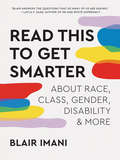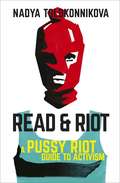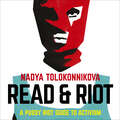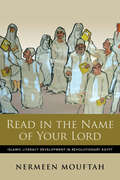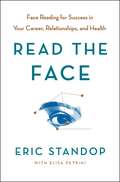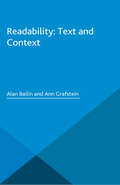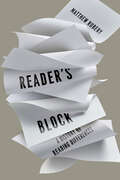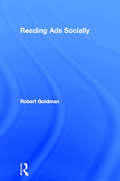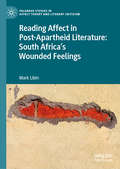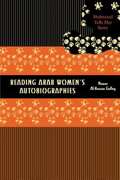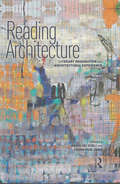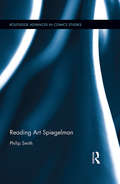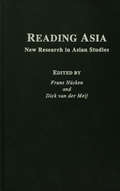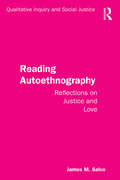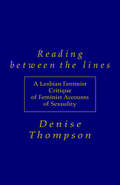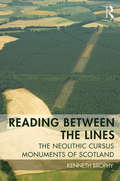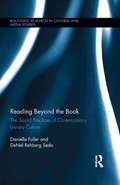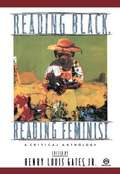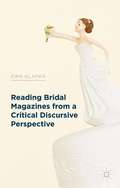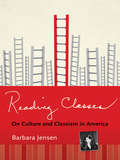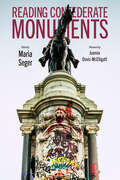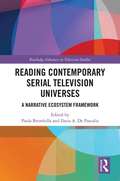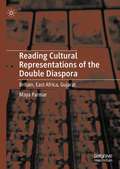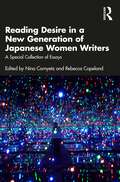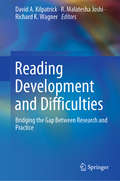- Table View
- List View
Read This to Get Smarter: about Race, Class, Gender, Disability & More
by Blair ImaniAn approachable guide to being an informed, compassionate, and socially conscious person today—from discussions of race, gender, and sexual orientation to disability, class, and beyond—from critically acclaimed historian, educator, and author Blair Imani.&“Blair answers the questions that so many of us are asking.&”—Layla F. Saad, author of Me and White SupremacyWe live in a time where it has never been more important to be knowledgeable about a host of social issues, and to be confident and appropriate in how to talk about them. What&’s the best way to ask someone what their pronouns are? How do you talk about racism with someone who doesn&’t seem to get it? What is intersectionality, and why do you need to understand it? While it can seem intimidating or overwhelming to learn and talk about such issues, it&’s never been easier thanks to educator and historian Blair Imani, creator of the viral sensation Smarter in Seconds videos.Accessible to learners of all levels—from those just getting started on the journey to those already versed in social justice—Read This to Get Smarter covers a range of topics, including race, gender, class, disability, relationships, family, power dynamics, oppression, and beyond. This essential guide is a radical but warm and non-judgmental call to arms, structured in such a way that you can read it cover to cover or start with any topic you want to learn more about.With Blair Imani as your teacher, you&’ll &“get smarter&” in no time, and be equipped to intelligently and empathetically process, discuss, and educate others on the crucial issues we must tackle to achieve a liberated, equitable world.
Read and Riot: A Pussy Riot Guide to Activism
by Nadya Tolokonnikova"as indispensable to confronting, say, your domineering mother-in-law or your local city council as it is to helping foment an ongoing and ever-escalating insurrection against, say, a sexist, racist, nepotistic power-mad oligarchy threatening to destroy democracy as we know it...My advice: Buy one" - VOGUEA guerrilla guide to radical protest and joyful political resistance from artist, activist and Pussy Riot founder Nadya Tolokonnikova. The face of modern protest is wearing a brightly colored ski mask.Nadya Tolokonnikova, founding member of the Russian activist group Pussy Riot, is a creative activist, professional protestor, brazen feminist, shocking visual artist, and force to be reckoned with. Her spontaneous, explosive approach to political action has involved jumping over barbed wire, kissing police officers, giving guerilla performances in crowded subway cars, and going on a hunger strike to protest the abuse of prisoners. She's been horse-whipped by police in Sochi, temporarily blinded when officers threw green paint in her eyes, and monitored by the Russian government. But what made Nadya an activist icon overnight happened on February 21, 2012, when she was arrested for performing an anti-Putin protest song in a Moscow church.She was sent to a Russian prison for 18 months and emerged as an international symbol of radical resistance, as calls to "Free Pussy Riot" resounded around the world. With her emblematic ski mask, black lipstick, and unwavering bravery, Nadya has become an emissary of hope and optimism despite overwhelming and ugly political corruption.Read & Riot is structured around Nadya's ten rules for revolution (Be a pirate! Make your government shit its pants! Take back the joy!) and illustrated throughout with stunning examples from her extraordinary life and the philosophies of other revolutionary rebels throughout history. Rooted in action and going beyond the typical "call your senator" guidelines, Read & Riot gives us a refreshing model for civil disobedience, and encourages our right to question every status quo and make political action exciting--even joyful.
Read and Riot: A Pussy Riot Guide to Activism
by Nadya Tolokonnikova"Stylish, striking, and elegantly packaged...as indispensible to confronting, say, your domineering mother-in-law or your local city council as it is to helping foment an ongoing and ever-escalating insurrection against, say, a sexist, racist, nepotistic power-mad oligarchy threatening to destory democracy as we know it...My advice: Buy one" - VOGUEFrom artist, activist, and Pussy Riot founder Nadya Tolokonnikova, a guerilla guide to radical protest and joyful political resistanceThe face of modern protest is wearing a brightly colored ski mask.Nadya Tolokonnikova, founding member of the Russian activist group Pussy Riot, is a creative activist, professional protestor, brazen feminist, shocking visual artist, and force to be reckoned with. Her spontaneous, explosive approach to political action has involved jumping over barbed wire, kissing police officers, giving guerilla performances in crowded subway cars, and going on a hunger strike to protest the abuse of prisoners. She's been horse-whipped by police in Sochi, temporarily blinded when officers threw green paint in her eyes, and monitored by the Russian government. But what made Nadya an activist icon overnight happened on February 21, 2012, when she was arrested for performing an anti-Putin protest song in a Moscow church.She was sent to a Russian prison for 18 months and emerged as an international symbol of radical resistance, as calls to "Free Pussy Riot" resounded around the world. With her emblematic ski mask, black lipstick, and unwavering bravery, Nadya has become an emissary of hope and optimism despite overwhelming and ugly political corruption.Read & Riot is structured around Nadya's ten rules for revolution (Be a pirate! Make your government shit its pants! Take back the joy!) and illustrated throughout with stunning examples from her extraordinary life and the philosophies of other revolutionary rebels throughout history. Rooted in action and going beyond the typical "call your senator" guidelines, Read & Riot gives us a refreshing model for civil disobedience, and encourages our right to question every status quo and make political action exciting--even joyful.(P)2019 Hodder & Stoughton Limited
Read in the Name of Your Lord: Islamic Literacy Development in Revolutionary Egypt (Public Cultures of the Middle East and North Africa)
by Nermeen MouftahEgypt's January 2011 uprising spurred millions to action with a cacophony of demands—including the call to address Egypt's education crisis and adult literacy rates. Read in the Name of Your Lord traces the push for universal literacy as a project caught between revolutionary activism and Islamic reformism in post-Mubarak Egypt. Despite their many disagreements, religious reformers, revolutionaries, and state actors converged on literacy as the first step toward realizing aspirations of the revolution. They invoked the verse Muslims believe was the first to be revealed, "Read in the name of your Lord," to teach literacy as a religious duty and the foundation for the country's future. Nermeen Mouftah unravels how this religiously inspired push for universal literacy was born of twenty-first-century scripturalism and simultaneously went beyond the Quran, to make reading and writing virtuous acts of the liberal state. While revolutionary literacy campaigns soon vanished and adult literacy rates remained stubbornly low, their efforts revealed the importance of recognizing alternative modes of text processing and the personhood and knowledge of nonliterate people. Read in the Name of Your Lord demonstrates how the rise in modern scripturalism underpinned literacy activism, blurring the binary between secular and religious knowledge.
Read the Face: Face Reading for Success in Your Career, Relationships, and Health
by Elisa Petrini Eric StandopRelearn the intuitive language of face reading From birth, face is our first language. We are born face readers—knowing to seek out human features and faces from the moment our eyes open. We all have the intuitive ability to read and interpret the feelings and expressions of those around us. In Read the Face, master face reader Eric Standop unlocks the power of this innate human ability, sharing his own journey to become a face reading master, along with stories that illustrate the power of this unique language. Using a combination of three different schools of face reading, along with a scientific accuracy to detect the most fleeting microexpressions, Standop is able to read personality, character, emotions, and even the state of a person’s health—all from simply glancing at their face. The book is divided into sections focusing on specific ways that face reading can offer insight, such as Health, Love, Communication, Work and Success. The stories are accompanied by detailed black and white illustrations of faces, allowing readers to observe the same features that Standop interpreted. The final section of the book outlines the meanings of dozens of facial features and face shapes, so that readers can recognize their own innate intuitive powers and develop them. Read the Face is a guide to using the ancient art and science of face reading to go beyond the surface and create the boldest life possible.
Readability: Text and Context
by Alan Bailin Ann GrafsteinThis book explores what makes a book readable by bringing together the relevant literature and theories, and situating them within a unified account. It provides a single resource that offers a principled discussion of the issues and their applications.
Reader's Block: A History of Reading Differences
by Matthew RuberyWhat does the term "reading" mean? Matthew Rubery's exploration of the influence neurodivergence has on the ways individuals read asks us to consider that there may be no one definition. This alternative history of reading tells the stories of "atypical" readers and the impact had on their lives by neurological conditions affecting their ability to make sense of the printed word: from dyslexia, hyperlexia, and alexia to synesthesia, hallucinations, and dementia. Rubery's focus on neurodiversity aims to transform our understanding of the very concept of reading. Drawing on personal testimonies gathered from literature, film, life writing, social media, medical case studies, and other sources to express how cognitive differences have shaped people's experiences both on and off the page, Rubery contends that there is no single activity known as reading. Instead, there are multiple ways of reading (and, for that matter, not reading) despite the ease with which we use the term. Pushing us to rethink what it means to read, Reader's Block moves toward an understanding of reading as a spectrum that is capacious enough to accommodate the full range of activities documented in this fascinating and highly original book. Read it from cover to cover, out of sequence, or piecemeal. Read it upside down, sideways, or in a mirror. For just as there is no right way to read, there is no right way to read this book. What matters is that you are doing something with it—something that Rubery proposes should be called "reading."
Reading Ads Socially
by Robert GoldmanThis systematic and authoritative book provides an unrivalled guide to understanding ad culture. It shows how the logic of commodities permeates the ways we think about ourselves, our relationships and our desires. Richly illustrated and written with great clarity, it will be essential reading for anyone interested in ad culture.
Reading Affect in Post-Apartheid Literature: South Africa's Wounded Feelings (Palgrave Studies in Affect Theory and Literary Criticism)
by Mark LibinThis book examines South Africa’s post-apartheid culture through the lens of affect theory in order to argue that the socio-political project of the “new” South Africa, best exemplified in their Truth and Reconciliation Commission Hearings, was fundamentally an affective, emotional project. Through the TRC hearings, which publicly broadcast the testimonies of both victims and perpetrators of gross human rights violations, the African National Congress government of South Africa, represented by Nelson Mandela and Archbishop Desmond Tutu, endeavoured to generate powerful emotions of contrition and sympathy in order to build an empathetic bond between white and black citizens, a bond referred to frequently by Tutu in terms of the African philosophy of interconnection: ubuntu. This book explores the representations of affect, and the challenges of generating ubuntu, through close readings of a variety of cultural products: novels, poetry, memoir, drama, documentary film and audio anthology.
Reading Arab Women's Autobiographies: Shahrazad Tells Her Story
by Nawar Al-Hassan GolleyAuthors of autobiographies are always engaged in creating a "self" to present to their readers. This process of self-creation raises a number of intriguing questions: why and how does anyone choose to present herself or himself in an autobiography? Do women and men represent themselves in different ways and, if so, why? How do differences in culture affect the writing of autobiography in various parts of the world?
Reading Architecture: Literary Imagination and Architectural Experience
by Angeliki Sioli Yoonchun JungWhy write instead of draw when it comes to architecture? Why rely on literary pieces instead of architectural treatises and writings when it comes to the of study buildings and urban environments? Why rely on literary techniques and accounts instead of architectural practices and analysis when it comes to academic research and educational projects? Why trust authors and writers instead of sociologists or scientists when it comes to planning for the future of cities? This book builds on the existing interdisciplinary bibliography on architecture and literature, but prioritizes literature’s capacity to talk about the lived experience of place and the premise that literary language can often express the inexpressible. It sheds light on the importance of a literary instead of a pictorial imagination for architects and it looks into four contemporary architectural subjects through a wide variety of literary works. Drawing on novels that engage cities from around the world, the book reveals aspects of urban space to which other means of architectural representation are blind. Whether through novels that employ historical buildings or sites interpreted through specific literary methods, it suggests a range of methodologies for contemporary architectural academic research. By exploring the power of narrative language in conveying the experience of lived space, it discusses its potential for architectural design and pedagogy. Questioning the massive architectural production of today’s globalized capital-driven world, it turns to literature for ways to understand, resist or suggest alternative paths for architectural practice. Despite literature’s fictional character, the essays of this volume reveal true dimensions of and for places beyond their historical, social and political reality; dimensions of utmost importance for architects, urban planners, historians and theoreticians nowadays.
Reading Art Spiegelman (Routledge Advances in Comics Studies)
by Philip SmithThe horror of the Holocaust lies not only in its brutality but in its scale and logistics; it depended upon the machinery and logic of a rational, industrialised, and empirically organised modern society. The central thesis of this book is that Art Spiegelman’s comics all identify deeply-rooted madness in post-Enlightenment society. Spiegelman maintains, in other words, that the Holocaust was not an aberration, but an inevitable consequence of modernisation. In service of this argument, Smith offers a reading of Spiegelman’s comics, with a particular focus on his three main collections: Breakdowns (1977 and 2008), Maus (1980 and 1991), and In the Shadow of No Towers (2004). He draws upon a taxonomy of terms from comic book scholarship, attempts to theorize madness (including literary portrayals of trauma), and critical works on Holocaust literature.
Reading Asia: New Research in Asian Studies
by Dick van Meij Frans HuskinThis volume presents a wide variety of articles in the broad field of Asian Studies, covering the latest results of research within the social sciences and the humanities, reflecting the rich diversity within these areas of research.The contributions stem from research carried out by scholars who are or have been affiliated with the International Institute for Asian Studies (Leiden/Amsterdam).
Reading Autoethnography: Reflections on Justice and Love (Qualitative Inquiry and Social Justice)
by James M. SalvoReading Autoethnography situates autoethnographic insights within the context of two fundamental concerns of critical qualitative inquiry: justice and love. Through philosophical engagement, it gives close readings of written passages taken from leading autoethnographers and frames the philosophical project of autoethnography as one that is both political and interpersonal. It does this to highlight how autoethnographic lessons can allow us to think through how we may achieve a flourishing for all — something that is both related to justice as it pertains to the political, and when situations are in excess of justice, related to love as it pertains to feeling at home in the world with others. As such, this book will be of interest to those who have a burgeoning interest in autoethnography and seasoned autoethnographers alike; anyone interested in critical qualitative inquiry as a discourse promoting justice and love; and any scholar who has encountered the ethical question of: "What ought we do?"
Reading Between the Lines: A Lesbian Feminist Critique of Feminist Accounts of Sexuality
by Denise ThompsonA critical analysis of feminist writings on sexuality from a radical feminist and lesbian feminist standpoint. Critical of libertarianism, Denise Thompson provides a detailed analysis of the mechanisms of domination and the ways in which feminist theory is marginalised. A must-read for any serious feminist thinker.
Reading Between the Lines: The Neolithic Cursus Monuments of Scotland
by Kenneth BrophyReading Between the Lines: The Neolithic Cursus Monuments of Scotland is the first systematic analysis of Scotland’s cursus monuments and is written by one of the foremost scholars of the Neolithic in Scotland. Drawing on fifteen years of experience of cropmark interpretation, as well as his involvement in several excavations of cursus monuments and contemporary sites, Kenneth Brophy uncovers some of the secrets of the Neolithic landscape. While outlining the physical characteristics of the cursus, this book also addresses the limitations of this kind of typological description when applied to monuments which varied so remarkably in terms of materiality and size. Moving beyond a morphological account, Brophy considers what can be said of this diverse group of sites, and how they were actually built and used in prehistory, in light of several decades of aerial reconnaissance and excavation in Scotland. Through a close study of the differences, as well as the similarities, between these structures, this book offers a nuanced account of cursus monuments, finally allowing this important monument type to be better understood and placed alongside others of the period. Offering exciting new ways of thinking about these enigmatic yet important monuments, Reading Between the Lines: The Neolithic Cursus Monuments of Scotland is an essential resource for students and specialists in British prehistory, providing an introduction to the Early Neolithic archaeology of lowland Scotland as well as a meditation on broader aspects of monumentality and architecture.
Reading Beyond the Book: The Social Practices of Contemporary Literary Culture (Routledge Research in Cultural and Media Studies #49)
by Danielle Fuller DeNel Rehberg SedoLiterary culture has become a form of popular culture over the last fifteen years thanks to the success of televised book clubs, film adaptations, big-box book stores, online bookselling, and face-to-face and online book groups. This volume offers the first critical analysis of mass reading events and the contemporary meanings of reading in the UK, USA, and Canada based on original interviews and surveys with readers and event organizers. The resurgence of book groups has inspired new cultural formations of what the authors call "shared reading." They interrogate the enduring attraction of an old technology for readers, community organizers, and government agencies, exploring the social practices inspired by the sharing of books in public spaces and revealing the complex ideological investments made by readers, cultural workers, institutions, and the mass media in the meanings of reading.
Reading Black, Reading Feminist: A Critical Anthology
by Henry Louis Gates Jr.This anthology of essays critically analyzes literature written by African-American women. The contributors of the essays include Dorothy Allison, Houston A. Baker Jr., Barbara Christian, Marianne Hirsch, John Shoptaw, and Hortense Spillers.
Reading Bridal Magazines from a Critical Discursive Perspective
by Ewa GlapkaBridal magazines have become increasingly popular in Western society, proliferating the idea of a 'princess bride' on her 'big day'. Yet little has been written on how the ever-expanding wedding media and the popular wedding culture constructs gender and affects the ways women live and experience their weddings. Offering a critique of contemporary wedding discourse, this book marries together analyses of media texts and their reception to propose a new approach to media discourse. The analysis richly illustrates how women are invited to embrace not only the stereotypical idea of bridal femininity but also a consumptive way of experiencing it. Through examination of brides' accounts of their 'big days', the book observes the imprints of the popular gender imagery on their self-portraits and self-narratives, and describes the women's diverse approaches to them. Based on insights from gender and critical discourse studies, sociology and audience research, this exploration illuminates the ongoing debate on 'media and gender' and its methodological approaches.
Reading Classes
by Barbara JensenDiscussions of class make many Americans uncomfortable. This accessible book makes class visible in everyday life. Solely identifying political and economic inequalities between classes offers an incomplete picture of class dynamics in America, and may not connect with people's lived experiences. In Reading Classes, Barbara Jensen explores the anguish caused by class in our society, identifying classism-or anti–working class prejudice-as a central factor in the reproduction of inequality in America. Giving voice to the experiences and inner lives of working-class people, Jensen-a community and counseling psychologist-provides an in-depth, psychologically informed examination of how class in America is created and re-created through culture, with an emphasis on how working- and middle-class cultures differ and conflict. This book is unique in its claim that working class cultures have positive qualities that serve to keep members within them; that can haunt those who leave them behind. Through both autobiographical reflections on her dual citizenship in the working class and middle class and the life stories of students, clients, and relatives, Jensen brings into focus the clash between the realities of working-class life and middle-class expectations for working-class people. Focusing on education, she finds that at every point in their personal development and educational history, working-class children are misunderstood, ignored, or disrespected by middle-class teachers and administrators. Education, while often hailed as a way to "cross classes," brings with it its own set of conflicts and internal struggles. These problems can lead to a divided self, resulting in alienation and suffering for the upwardly mobile student. Jensen suggests how to increase awareness of the value of working-class cultures to a truly inclusive American society at personal, professional, and societal levels.
Reading Confederate Monuments
by Joanna Davis-McElligattContributions by Danielle Christmas, Joanna Davis-McElligatt, Garrett Bridger Gilmore, Spencer R. Herrera, Cassandra Jackson, Stacie McCormick, Maria Seger, Randi Lynn Tanglen, Brook Thomas, Michael C. Weisenburg, and Lisa Woolfork Reading Confederate Monuments addresses the urgent and vital need for scholars, educators, and the general public to be able to read and interpret the literal and cultural Confederate monuments pervading life in the contemporary United States.The literary and cultural studies scholars featured in this collection engage many different archives and methods, demonstrating how to read literal Confederate monuments as texts and in the context of the assortment of literatures that produced and celebrated them. They further explore how to read the literary texts advancing and contesting Confederate ideology in the US cultural imaginary—then and now—as monuments in and of themselves. On top of that, the essays published here lay bare the cultural and pedagogical work of Confederate monuments and counter-monuments—divulging how and what they teach their readers as communal and yet contested narratives—thereby showing why the persistence of Confederate monuments matters greatly to local and national notions of racial justice and belonging. In doing so, this collection illustrates what critics of US literature and culture can offer to ongoing scholarly and public discussions about Confederate monuments and memory. Even as we remove, relocate, and recontextualize the physical symbols of the Confederacy dotting the US landscape, the complicated histories, cultural products, and pedagogies of Confederate ideology remain embedded in the national consciousness. To disrupt and potentially dismantle these enduring narratives alongside the statues themselves, we must be able to recognize, analyze, and resist them in US life. The pieces in this collection position us to think deeply about how and why we should continue that work.
Reading Contemporary Serial Television Universes: A Narrative Ecosystem Framework (Routledge Advances in Television Studies)
by Paola Brembilla Ilaria A. De PascalisReading Contemporary Serial Television Universes provides a new framework—the metaphor of the narrative ecosystem—for the analysis of serial television narratives. Contributors use this metaphor to address the ever-expanding and evolving structure of narratives far beyond their usual spatial and temporal borders, in general and in reference to specific series. Other scholarly approaches consider each narrative as composed of modular elements, which combine to create a bigger picture. The narrative ecosystem approach, on the other hand, argues that each portion of the narrative world contains all of the main elements that characterize the world as a whole, such as narrative tensions, production structures, creative dynamics and functions. The volume details the implications of the narrative ecosystem for narrative theory and the study of seriality, audiences and fandoms, production, and the analysis of the products themselves.
Reading Cultural Representations of the Double Diaspora: Britain, East Africa, Gujarat
by Maya ParmarReading Cultural Representations of the Double Diaspora: Britain, East Africa, Gujarat is the first detailed study of the cultural life and representations of the prolific twice-displaced Gujarati East African diaspora in contemporary Britain. An exceptional community of people, this diaspora is disproportionally successful and influential in resettlement, both in East Africa and Britain. Often showcased as an example of migrant achievement, their accomplishments are paradoxically underpinned by legacies of trauma and deracination. The diaspora, despite its economic success and considerable upward social mobility in Britain, has until now been overlooked within critical literary and postcolonial studies for a number of reasons. This book attends to that gap. Parmar uniquely investigates what it is to be not just from India, but too Africa—how identity forms within, as the study coins, the “double diaspora”. Parmar focuses on cultural representation post-twice migration, via an interdisciplinary methodology, offering new contributions to debates within diaspora studies. In doing so, the book examines a range of cultures produced amongst, or about, the diaspora, including literary representations, culinary, dance and sartorial practices, as well as visual materials.
Reading Desire in a New Generation of Japanese Women Writers: A Special Collection of Essays
by Rebecca Copeland Nina CornyetzThis book explores desire through the work of a new generation of Japanese women writers, in response to the increased attention these writers have received following the release of their work in the English language. The contributions explore a wide range of theoretical approaches and psychoanalytic interpretations to "reading" a new generation of Japanese women writers’ relationships to identity, sex/gender, and desire. Through dealing with female spaces, maternal roles, gendered bodies, or resistant speech acts, the book uncovers the overarching theme of desire – desire for language, touch, and recognition. Focusing on authors who have previously been underrepresented in English-language scholarship, the book highlights the diverse nature and the important synergies of writing by women in the last few decades. Addressing experimental and nonconforming authors whose works challenge gender and culture expectation as well as Orientalist myths, this will be a valuable resource for students and scholars of Asian literature, Japanese culture, and Asian studies.
Reading Development and Difficulties: Bridging the Gap Between Research and Practice
by R. Malatesha Joshi David A. Kilpatrick Richard K. WagnerThis book provides an overview of current research on the development of reading skills as well as practices to assist educational professionals with assessment, prevention, and intervention for students with reading difficulties. The book reviews the Componential Model of Reading (CMR) and provides assessment techniques, instructional recommendations, and application models. It pinpoints specific cognitive, psychological, and environmental deficits contributing to low reading skills, so educators can accurately identify student problems and design and implement appropriate interventions. Chapters offer methods for assessing problems in decoding, word and sound recognition, and comprehension. In addition, chapters emphasize the recognition of student individuality as readers and learners, from understanding distinctions between difficulties and disabilities to the effects of first-language orthography on second-language learning. Topics featured in this book include:Learning the structure of language at the word level.Reading comprehension and reading comprehension difficultiesAssessing reading in second language learners.Effective prevention and intervention for word-level reading difficulties.The neurobiological nature of developmental dyslexia. Reading Development and Difficulties is a must-have resource for researchers, practitioners, and graduate students in varied fields, including child and school psychology; assessment, testing, and evaluation; social work; and special education. "I think the book has the potential to be a game changer. It will certainly challenge the expectations of policy makers, not to mention the teachers of beginning readers. These chapters will enhance the knowledge base of those in our schools who are charged with the lofty task of assuring that children have the best possible opportunities to acquire the skill of reading.” Sir Jim RoseChair and author of Independent Review of the Teaching of Early Reading: Final Report (2006)
